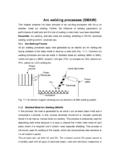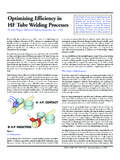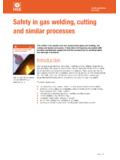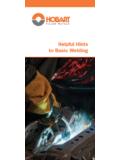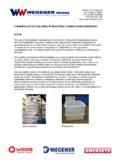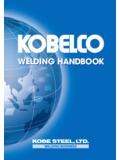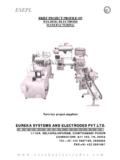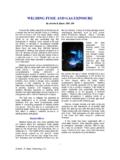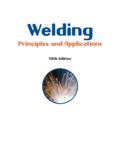Transcription of COSHH essentials WL20 - Health and Safety Executive
1 Health and Safety Executive 20. WL2. COSHH essentials Surface preparation: Pressure blasting for welding , hot work (large items). and allied processes Control approach R RPE. This information will help Access and premises employers (including the Exclude all unprotected workers. self-employed) comply with Designate an exclusion zone. Set up barriers and post warning signs. the Control of Substances Can you do larger jobs at meal breaks or out of normal work hours? Hazardous to Health Regulations 2002 ( COSHH ), as amended, to Equipment control exposure and protect workers' Can you use wet blasting or high-pressure water jetting in place of dry Health . abrasive blasting? It is also useful for trade union Safety Provide respiratory protective equipment (RPE). representatives. Provide blasting equipment with a fast-actuating cut-off under the operator's control. Abrasive blasting produces a great deal of Assistants (eg kettlemen) may also require RPE.
2 Dust. There is an increased risk of lung Wherever possible, do this work in a fully enclosed booth. disease. Procedures This sheet describes good practice using respiratory protective equipment (RPE). Make sure that workers check their RPE works properly every time they put it on. It covers the points you need to follow to Visually check compressed gas and air lines for signs of damage reduce exposure to an adequate level. before use. It is important to follow all the points, or Make sure that blast hoses are uncoiled for use. use equally effective measures. Never tape down the automatic cut-off or point the nozzle anywhere other than the working surface. Sand is banned as a blasting abrasive. Maintenance, examination and testing Also protect workers from noise. It is vitally important to maintain RPE in effective and efficient working Main points order. Dust from blasting can cause serious Follow the instructions in the manual.
3 Lung diseases. If any equipment is faulty, stop work until it is repaired. Keep exposure as low as possible Make sure that users examine their RPE and test it works properly before each use. using all the controls in this sheet. Health monitoring is usually needed. Examine and test RPE thoroughly at least once every three months. See sheet G401. Check the air flow and air quality to air-fed RPE at least once every three months or before use. Ensure that compressors, including any mobile compressors, take in only clean air. Keep records of all examinations and tests for at least five years. Review records - failure patterns show where preventive maintenance is needed. welding , hot work and allied processes WL20 Respiratory protective equipment (RPE). Personal protective equipment (PPE). Ask your Safety equipment supplier to help you get the right PPE. Provide storage for clean and contaminated PPE.
4 Respiratory protective equipment (RPE). RPE is always needed. Use a compressed air line-helmet to BS EN 270 standard. See sheet R5. Use a P3 standard of RPE (assigned protection factor 20) for maintenance and cleaning. See sheet R3. Make sure all RPE is properly fit-tested - get advice from your supplier. Make sure that workers check their RPE works properly before use. Replace RPE filters as recommended by your supplier. Throw away disposable masks after one use. Keep RPE clean and store it away from dust. Other protective equipment Provide and ensure that workers use blasting suits and protective gloves. Use a properly equipped contract laundry or a suitable equivalent to wash work clothing. Skin creams help in washing contamination from the skin. After-work creams help to replace skin oils. Caution: Never allow use of compressed air for removing dust from clothing.
5 Health monitoring You should consider Health monitoring. See sheet G401. Consult an occupational Health professional - see Useful links'. Cleaning and housekeeping Clear up abrasive spills and dusts every day. Use a Type H vacuum cleaner fitted with a HEPA filter to clear up dust. Caution: Don't clean up with a brush or compressed air. Training and supervision Tell workers that dust from surface treatment processes can cause serious lung diseases. Working in the right way and using the controls correctly is important for exposure control. Train and supervise workers. See sheet WL0. Further information Respiratory protective equipment at work: A practical guide HSG53 (Third edition) HSE Books 2005 ISBN 0 7176 2904 X. For environmental guidelines see sheet WL0. welding , hot work and allied processes WL20 Respiratory protective equipment (RPE). Useful links Employee checklist Your trade association may advise on Health and Safety consultants Do you know how to use and training providers.
6 The controls properly? For information about Health and Safety , or to report inconsistencies or inaccuracies in this guidance, visit You can view Is your RPE working HSE guidance online and order priced publications from the website. properly? HSE priced publications are also available from bookshops. Check the RPE clean air Contact the British Occupational Hygiene Society (BOHS) on 01332. supply. 298101 or at for lists of qualified hygienists who can help you. Is the exclusion area Look in the Yellow Pages under Health and Safety consultants' and marked? Health authorities and services' for occupational Health '. Use, maintain and store Also see your protective equipment in accordance with instructions. Look for signs of leaks, wear and damage. If you find any problems, tell your supervisor. Don't just carry on working. Co-operate with Health monitoring. Wash your hands before eating, drinking, or using the lavatory.
7 Never clean your hands with solvents or concentrated cleaning products. Use skin creams provided as instructed. This document is available at: and This document contains notes on good practice which are not compulsory but which you may find helpful in considering what you need to do. Crown copyright If you wish to reuse this information visit for details. First published 04/06. Published by the Health and Safety Executive 08/11.










